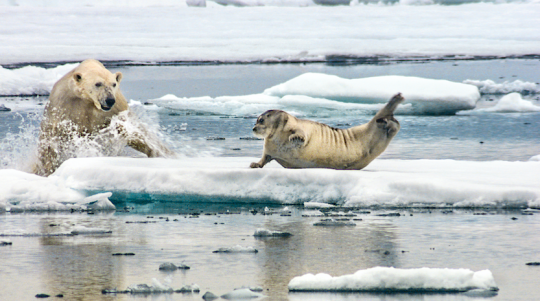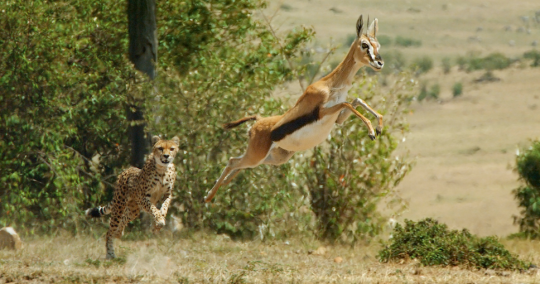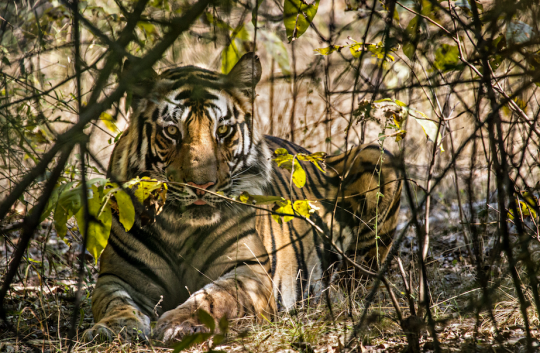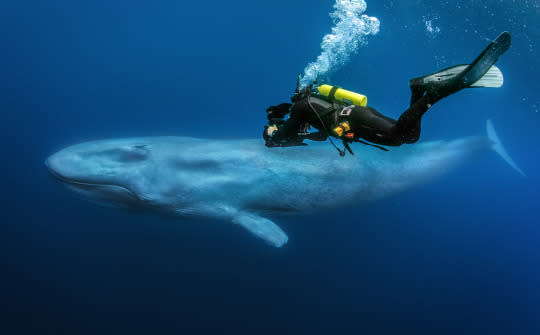‘The Hunt’: How Producers Made Sure There Are No Villains

A polar bear launches itself out of the water at a bearded seal (Silverback Films)
There’s something you should know about BBC America’s new series The Hunt, premiering July 3, from the makers of Planet Earth and narrated by Sir David Attenborough: It’s always beautiful and fascinating, and only occasionally traumatizing.
“We knew that predation is the most exciting behavior in nature, and so that’s what really fired us up. At the same time, we felt very strongly that in the past it has always been done in the same way, and in our view, the wrong way,” executive producer Alastair Fothergill tells Yahoo TV. “Predators were depicted as red in tooth and claw, they were the villains, and actually, they usually fail, and actually, the kill is not interesting. What’s interesting is the build up and the backstory and the strategies.”
That’s what the eight-episode series is really about: Building an emotional attachment to these iconic (and lesser known) predators and, as in the Aug. 14 installment “Living with Predators — Conservation,” reminding us that if we’re not careful, we could lose them.
Fothergill and series producer Huw Cordey offered us a preview.

A cheetah gives chase (Silverback Films)
Yahoo TV: One of the ways the series successfully conveys that there are no heroes and no villains is how you pair sequences. In the premiere episode, “The Hardest Challenge,” you go from a sequence of orcas trying to separate a humpback calf from its mother, right to one of a cheetah mother hunting to feed her four cubs — and we’re told that 90 percent of cheetah cubs don’t make it to their second birthday. How important was it to convey that “no villains” message early?
Huw Cordey: As Alastair said, they fail most of the time. We wanted to see all the elements that make a predator’s life so difficult. We wanted to create a lot of sympathy and empathy for the predators. That’s why it’s important to have that variety, to see what’s at stake for a predator. You can see the cheetah trying to raise four cubs — that’s important for people to understand that there’s so much more to predators’ lives than just running, chasing, and eating.
Alastair Fothergill: I think one of those things we’re proud about is, from the audience feedback and screenings we did in the UK, people were really rooting for the predators. I mean, in the polar episode [July 10′s “In The Grip Of Seasons — Arctic”], people really wanted that starving polar bear female to finally succeed after so much failure. So if we did that, then we’re pleased.
At one point, we see a polar bear trying to stealthily move closer to a seal by popping up in meltwater pools (breaks in the ice). The music is playful, because the bear gets disoriented and pops up farther away. How crucial is it to seize those moments of levity?
Cordey: I’m glad you picked up on that, because it was again something that we wanted to do right from the start. You know, you wouldn’t traditionally think of a series on predators as having humorous moments, but I think it was important to try to create that levity and lightness in touch in places. Every episode, I think, had something like that. In the opening episodes, we did that with the Darwin’s Bark Spider, or the chameleons and the praying mantis. I think it was an important way of trying to make people think differently about predators.
On the opposite end, we watch a starving polar bear scavenging for bird eggs on a 300-meter cliff during the summer. What if it had fallen? You would have included that in the film?
Cordey: We were very, very lucky to get that. We knew about it, we were going for it, but getting it was just a really, really big piece of luck. It is extraordinary to see an animal as big as that on a precipitous slope. I didn’t even know enough about the behavior to know how often they fall, but you can imagine it does happen. If it had fallen or injured itself, it sort of played into our hands that the life of a predator is extremely difficult.

(Adrian Seymour/Silverback Films)
The footage of a tiger stalking prey in episode 3, July 17′s Hide and Seek — Jungles, is also amazing, seeing how slowly and delicately they put their paws down to avoid making noise.
Cordey: A lot of those sequences we filmed with a gyroscope-like camera on a car, or, in the case of the tiger, we had it on an elephant. What we really wanted to do, right from the start, was get the viewer in the footsteps of the predator so that we could follow it as it moves through its habitat. The only way to do that was to have the camera on a vehicle that was constantly ready to go. You can imagine if you were filming with a traditional camera, the footage would be so wobbly it would be unusable. By using a gyro-stabilized camera, like the systems we used in Planet Earth in the helicopters, it allowed us to have these beautifully smooth tracking shots as we followed, for example, wild dogs running at 40 miles an hour, or the gentle stalking of a leopard, or in the case of the tiger, a gyro-stabilized camera on a spoke rig that we hung off the side of an elephant.
Related: ‘The Hunt’ Review: Cougars Attack! Orcas Kill! Bunnies Die!
In “Hide And Seek — Jungles,” there’s also a riveting sequence of chimps hunting a monkey. How do you film something like that?
Fothergill: That was one of the hardest sequences in the whole series, and the reason for that is that that rain forest is so thick, you can be sitting with 40 chimps around you, and you know they’re there, but you can only see one or two of them. Also, that hunt is very, very fast. The chimps are moving fast and keeping up with the chimps and getting the shot was really hard. The cameraman used to say, having spent a whole day in the forest from dawn to dusk following the chimps — he might have done 25 miles running through the day, 100 percent humidity — that if he got one shot in the day, he was very, very pleased.
Literally, that was jigsawed together with day after day after day after day, because obviously, you can’t get up in the canopy, and be getting all the angles and building that story [in one day]. What’s interesting about that story is the cooperation. It’s sort of as near to man hunting as anything in the natural world. The different roles the different chimps play in setting the trap, it’s really fascinating.
So there’s just one camera going at a time?
Fothergill: Yes, it was basically one cameraman day after day after day after day after day. The good thing is, those particular chimps that we filmed, they hunt in a short period in the year. They hunt in the rainy season, which is two months in the fall, and they hunt then because the monkeys are more likely to slip on the branches. The problem that the chimps face is that the monkeys are much lighter than them, they’re probably a third of the weight of a chimp, maybe a quarter. So an intelligent monkey just goes to the end of a thin branch and says, “You can’t come out here, because if you do, we’ll both fall to our death.” So the chimps rely a lot on the monkey slipping or them setting the trap that you see in the sequence.
Were there rules for your cameramen and women? In episode 5, July 31′s Nowhere To Hide — Plains, we see a struggle between a buffalo and two lions that we’re told lasts 20 minutes. They take the bull down, and then it gets back up and runs away. Is the rule to keep rolling even after you think it’s time to stop?
Fothergill: It was a combination of two things. Because we knew a lot about all the stories we were going for, we did storyboard them, almost like an ad. We had a very clear idea that if we were going to visually raise the bar, if it was going to feel more like a drama than a traditional natural history series, you have to really storyboard that. That was constantly going on. But at the same time, nature always rewrites the script, and we were as surprised as anybody that that buffalo got away. The cameraman was absolutely certain it was the end. We go on filming, and we decide when to cut the action in the cutting room, and as you said earlier, there was quite a lot of blood and gore that we filmed but we didn’t choose to show. That’s quite a gory sequence, but I think it’s worth it, because in the end, it is a battle between a massive predator and a massive prey. And it was good to be there in the end when the buffalo got away.

Cameraman David Reichert filming a blue whale in the Pacific Ocean (Richard Herrmann/Silverback Films)
What sequence were you each most excited to see, the first time you watched the footage?
Fothergill: I think that Huw and I would have different ones. For me, I really like what we call the aquatic stalk, which is the summer stalk of the polar bear, because that had never been filmed properly before. People had gotten shots, but they’d never completely did it, and that’s because that’s in the middle of the summer, the ice is broken up, it’s a very difficult place to work. The wind could change and the ice could crush your boat. We had to use an icebreaker to get in there, and then we were launching small boats that were moving between the ice, a specially stabilized camera that allowed us to keep a long lens working in very difficult conditions. I also think the blue whale [in episode 4, July 24′s Hunger At Sea – Oceans] is extraordinary. Nobody has properly filmed blue whales feeding underwater before. Ever since Blue Planet, I’ve wanted to film blue whales, and for that sequence, we did four different shoots. We had an air helicopter shoot to do aerials, we had the Cineflex stabilized camera on a boat, and obviously we had divers in the water. That was particularly amazing. Many of the sequences we went back more than once for the same story to get all the angles, because if you’re going to raise it from documentary to drama, you need all the angles to actually tell the emotional storyline that you wouldn’t normally if this were a more traditional documentary.
Cordey: For me, my favorite sequence was the wild dogs hunting the wildebeest [in the July 3 premiere]. It was just such a phenomenal experience, traveling, running at 40 miles an hour. They’re only the size of a small greyhound, and to be able to pull down something as large as a wildebeest, it’s incredible. To be able to tackle something 10 times your weight. And then it’s fascinating to know that if you are a wildebeest and run, you’ve had it, but if you stand your ground, you might survive. We used to joke that what wildebeests needed was the courage to stand still and thankfully, for the wild dogs, most of the wildebeests didn’t have the courage to stand still. They had the fear to run, and nothing can outrun a [pack of wild dogs]. To be there while they’re hunting and to follow them into the action, it was an incredible privilege and just a remarkable thing to watch.
The Hunt premieres July 3 at 9 p.m. on BBC America, airing Sundays through Aug. 14.
